Learning Curve for Ultrasound Assessment of Myometrial Infiltration in Endometrial Cancer Visualizing Videoclips: Potential Implications for Training
Abstract
:1. Introduction
2. Materials and Methods
3. Results
4. Discussion
4.1. Summary of Findings
4.2. Interpretation of Results
4.3. Strenthgs and Limitations
5. Conclusions
Author Contributions
Funding
Institutional Review Board Statement
Informed Consent Statement
Data Availability Statement
Conflicts of Interest
References
- Lortet-Tieulent, J.; Ferlay, J.; Bray, F.; Jemal, A. International patterns and trends in endometrial cancer incidence, 1978-2013. J Natl Cancer Inst. 2018, 110, 354–361. [Google Scholar] [CrossRef] [PubMed] [Green Version]
- Amant, F.; Moerman, P.; Neven, P.; Timmerman, D.; Van Limbergen, E.; Vergote, I. Endometrial cancer. Lancet 2012, 366, 491–505. [Google Scholar] [CrossRef]
- Seracchioli, R.; Solfrini, S.; Mabrouk, M.; Facchini, C.; Di Donato, N.; Manuzzi, L.; Savelli, L.; Venturoli, S. Controversies in surgical staging of endometrial cancer. Obstet. Gynecol. Int. 2010, 2010, 181963. [Google Scholar] [CrossRef] [PubMed] [Green Version]
- Concin, N.; Matias-Guiu, X.; Vergote, I.; Cibula, D.; Mirza, M.R.; Marnitz, S.; Ledermann, J.; Bosse, T.; Chargari, C.; Fagotti, A.; et al. ESGO/ESTRO/ESP guidelines for the management of patients with endometrial carcinoma. Int. J. Gynecol. Cancer 2021, 31, 12–39. [Google Scholar] [CrossRef]
- Alcázar, J.L.; Gastón, B.; Navarro, B.; Salas, R.; Aranda, J.; Guerriero, S. Transvaginal ultrasound versus magnetic resonance imaging for preoperative assessment of myometrial infiltration in patients with endometrial cancer: A systematic review and meta-analysis. J. Gynecol. Oncol. 2017, 28, e86. [Google Scholar] [CrossRef] [Green Version]
- Alcázar, J.L.; Orozco, R.; Martinez-Astorquiza Corral, T.; Juez, L.; Utrilla-Layna, J.; Mínguez, J.A.; Jurado, M. Transvaginal ultrasound for preoperative assessment of myometrial invasion in patients with endometrial cancer: A systematic review and meta-analysis. Ultrasound Obstet. Gynecol. 2015, 46, 405–413. [Google Scholar] [CrossRef] [PubMed] [Green Version]
- Alcazar, J.L.; Pineda, L.; Martinez-Astorquiza Corral, T.; Orozco, R.; Utrilla-Layna, J.; Juez, L.; Jurado, M. Transvaginal/transrectal ultrasound for assessing myometrial invasion in endometrial cancer: A comparison of six different approaches. J. Gynecol. Oncol. 2015, 26, 201–207. [Google Scholar] [CrossRef] [Green Version]
- Alcázar, J.L.; Jurado, M.; López-García, G. Comparative study of transvaginal ultrasonography and CA 125 in the preoperative evaluation of myometrial invasion in endometrial carcinoma. Ultrasound Obstet. Gynecol. 1999, 14, 210–214. [Google Scholar] [CrossRef]
- Clark, A.E.; Shaw, C.J.; Bello, F.; Chalouhi, G.E.; Lees, C.C. Quantitating skill acquisition with optical ultrasound simulation. Australas J. Ultrasound Med. 2020, 23, 183–193. [Google Scholar] [CrossRef]
- Alcázar, J.L.; Díaz, L.; Flórez, P.; Guerriero, S.; Jurado, M. Intensive training program for ultrasound diagnosis of adnexal masses: Protocol and preliminary results. Ultrasound Obstet. Gynecol. 2013, 42, 218–223. [Google Scholar] [CrossRef]
- Guerriero, S.; Pascual, M.A.; Ajossa, S.; Rodriguez, I.; Zajicek, M.; Rolla, M.; Rams Llop, N.; Yulzari, V.; Bardin, R.; Buonomo, F.; et al. Learning curve for ultrasonographic diagnosis of deep infiltrating endometriosis using structured offline training program. Ultrasound Obstet. Gynecol. 2019, 54, 262–269. [Google Scholar] [CrossRef] [PubMed]
- Pascual, M.A.; Alcazar, J.L.; Graupera, B.; Rodriguez, I.; Guerriero, S.; Mallafre, A.; de Lorenzo, C.; Hereter, L. Training Performance in Diagnosis of Congenital Uterine Anomalies With 3-Dimensional Sonography: A Learning Curve Cumulative Summation Analysis. J. Ultrasound Med. 2016, 35, 2589–2594. [Google Scholar] [CrossRef]
- Abuhamad, A.; Minton, K.K.; Benson, C.B.; Chudleigh, T.; Crites, L.; Doubilet, P.M.; Driggers, R.; Lee, W.; Mann, K.V.; Perez, J.J.; et al. Obstetric and Gynecologic Ultrasound Curriculum and Competency Assessment in Residency Training Programs: Consensus Report. J. Ultrasound Med. 2018, 37, 19–50. [Google Scholar] [CrossRef] [PubMed] [Green Version]
- Leonardi, M.; Murji, A.; D’Souza, R. Ultrasound curricula in obstetrics and gynecology training programs. Ultrasound Obstet. Gynecol. 2018, 52, 147–150. [Google Scholar] [CrossRef] [Green Version]
- Biau, D.J.; Porcher, R.; Salomon, L.J. CUSUM: A tool for ongoing assessment of performance. Ultrasound Obstet. Gynecol. 2008, 31, 252–255. [Google Scholar] [CrossRef] [PubMed]
- Xholli, A.; Londero, A.P.; Jakimovska, M.; Zermano, S.; Puma, L.; Pasqual, E.M.; Kobal, B.; Cagnacci, A. An implementation of the learning curve cumulative summation test to evaluate a practicum for endometrial cancer ultrasound staging. Ultrasonography 2022, 42, 147–153. [Google Scholar] [CrossRef] [PubMed]
- Boyle, E.; O’Keeffe, D.A.; Naughton, P.A.; Hill, A.D.; McDonnell, C.O.; Moneley, D. The importance of expert feedback during endovascular simulator training. J. Vasc. Surg. 2011, 54, 240–248.e1. [Google Scholar] [CrossRef] [PubMed] [Green Version]
- Kristoffersen, M.B.; Franzke, A.W.; van der Sluis, C.K.; Murgia, A.; Bongers, R.M. The Effect of Feedback during Training Sessions on Learning Pattern-Recognition Based Prosthesis Control. IEEE Trans. Neural. Syst. Rehabil. Eng. 2019, 27, 2087–2096. [Google Scholar] [CrossRef] [PubMed] [Green Version]
- Alcázar, J.L.; Pineda, L.; Caparrós, M.; Utrilla-Layna, J.; Juez, L.; Mínguez, J.A.; Jurado, M. Transvaginal/transrectal ultrasound for preoperative identification of high- risk cases in well- or moderately differentiated endometrioid carcinoma. Ultrasound Obstet. Gynecol. 2016, 47, 374–379. [Google Scholar] [CrossRef] [Green Version]
- Green, R.W.; Valentin, L.; Alcazar, J.L.; Chiappa, V.; Erdodi, B.; Franchi, D.; Frühauf, F.; Fruscio, R.; Guerriero, S.; Graupera, B.; et al. Endometrial cancer off-line staging using two-dimensional transvaginal ultrasound and three-dimensional volume contrast imaging: Intermethod agreement, interrater reliability and diagnostic accuracy. Gynecol Oncol. 2018, 150, 438–445. [Google Scholar] [CrossRef]
- Cruz-Martinez, R.; Figueras, F.; Moreno-Alvarez, O.; Martinez, J.M.; Gomez, O.; Hernandez-Andrade, E.; Gratacos, E. Learning curve for lung area to head circumference ratio measurement in fetuses with congenital diaphragmatic hernia. Ultrasound Obstet Gynecol. 2010, 36, 32–36. [Google Scholar] [CrossRef] [PubMed]
- Arya, S.; Mulla, Z.D.; Kupesic Plavsic, S. Role of pelvic ultrasound simulation. Clin. Teach. 2018, 15, 457–461. [Google Scholar] [CrossRef] [PubMed]
- Taksøe-Vester, C.; Dyre, L.; Schroll, J.; Tabor, A.; Tolsgaard, M. Simulation-Based Ultrasound Training in Obstetrics and Gynecology: A Systematic Review and Meta-Analysis. Ultraschall Med. 2021, 42, e42–e54. [Google Scholar] [CrossRef] [PubMed]
- Waterman, B.; Van Aarsen, K.; Lewell, M.; Tien, H.; Myslik, F.; Peddle, M.; Doran, S. Abdominal ultrasound image acquisition and interpretation by novice practitioners after minimal training on a simulated patient model. CJEM 2020, 22, S62–S66. [Google Scholar] [CrossRef] [PubMed]
- Windrim, C.; Higgins, M.F. Transvaginal ultrasound simulation: An exploratory qualitative research study focused on the end-users perception of learning. Eur. J. Obstet. Gynecol. Reprod. Biol. 2022, 270, 201–205. [Google Scholar] [CrossRef]
- Pineda, L.; Alcázar, J.L.; Caparrós, M.; Mínguez, J.A.; Idoate, M.A.; Quiceno, H.; Solórzano, J.L.; Jurado, M. Agreement between preoperative transvaginal ultrasound and intraoperative macroscopic examination for assessing myometrial infiltration in low-risk endometrioid carcinoma. Ultrasound Obstet. Gynecol. 2016, 47, 369–373. [Google Scholar] [CrossRef] [Green Version]
- Eriksson, L.S.E.; Lindqvist, P.G.; Rådestad, A.F.; Dueholm, M.; Fischerova, D.; Franchi, D.; Jokubkiene, L.; Leone, F.P.; Savelli, L.; Sladkevicius, P.; et al. Transvaginal ultrasound assessment of myometrial and cervical stromal invasion in women with endometrial cancer: Interobserver reproducibility among ultrasound experts and gynecologists. Ultrasound Obstet. Gynecol. 2015, 45, 476–482. [Google Scholar] [CrossRef] [Green Version]
- Palmér, M.; Åkesson, Å.; Marcickiewicz, J.; Blank, E.; Hogström, L.; Torle, M.; Mateoiu, C.; Dahm-Kähler, P.; Leonhardt, H. Accuracy of transvaginal ultrasound versus MRI in the PreOperative Diagnostics of low-grade Endometrial Cancer (PODEC) study: A prospective multicentre study. Clin. Radiol. 2023, 78, 70–79. [Google Scholar] [CrossRef]
- Leonardi, M.; Ong, J.; Espada, M.; Stamatopoulos, N.; Georgousopoulou, E.; Hudelist, G.; Condous, G. One-Size-Fits-All Approach Does Not Work for Gynecology Trainees Learning Endometriosis Ultrasound Skills. J. Ultrasound Med. 2020, 39, 2295–2303. [Google Scholar] [CrossRef]
- Atkinson, N.S.; Bryant, R.V.; Dong, Y.; Maaser, C.; Kucharzik, T.; Maconi, G.; Asthana, A.K.; Blaivas, M.; Goudie, A.; Gilja, O.H.; et al. WFUMB Position Paper. Learning Gastrointestinal Ultrasound: Theory and Practice. Ultrasound Med. Biol. 2016, 42, 2732–2742. [Google Scholar] [CrossRef] [Green Version]
- Brunckhorst, O.; Volpe, A.; van der Poel, H.; Mottrie, A.; Ahmed, K. Training, Simulation, the Learning Curve, and How to Reduce Complications in Urology. Eur. Urol. Focus 2016, 2, 10–18. [Google Scholar] [CrossRef] [PubMed]
- Coyne, L.; Jayaprakasan, K.; Raine-Fenning, N. 3D ultrasound in gynecology and reproductive medicine. Womens Health (Lond). 2008, 4, 501–516. [Google Scholar] [CrossRef] [PubMed]
- van Veelen, G.A.; Schweitzer, K.J.; van der Vaart, C.H. Reliability of pelvic floor measurements on three- and four-dimensional ultrasound during and after first pregnancy: Implications for training. Ultrasound Obstet. Gynecol. 2013, 42, 590–595. [Google Scholar] [CrossRef] [PubMed]
- Ruiz de Gauna, B.; Sanchez, P.; Pineda, L.; Utrilla-Layna, J.; Juez, L.; Alcázar, J.L. Interobserver agreement in describing adnexal masses using the International Ovarian Tumor Analysis simple rules in a real-time setting and using three-dimensional ultrasound volumes and digital clips. Ultrasound Obstet Gynecol. 2014, 44, 95–99. [Google Scholar] [CrossRef]
- Indrielle-Kelly, T.; Fischerova, D.; Hanuš, P.; Frühauf, F.; Fanta, M.; Dundr, P.; Lavu, D.; Cibula, D.; Burgetova, A. Early Learning Curve in the Assessment of Deep Pelvic Endometriosis for Ultrasound and Magnetic Resonance Imaging. Biomed Res. Int. 2020, 2020, 8757281. [Google Scholar] [CrossRef]
- Eisenberg, V.H.; Alcazar, J.L.; Arbib, N.; Schiff, E.; Achiron, R.; Goldenberg, M.; Soriano, D. Applying a statistical method in transvaginal ultrasound training: Lessons from the learning curve cumulative summation test (LC-CUSUM) for endometriosis mapping. Gynecol Surg. 2017, 14, 19. [Google Scholar] [CrossRef] [Green Version]
- Ong, J.; Leonardi, M.; Espada, M.; Stamatopoulos, N.; Georgousopoulou, E.; Condous, G. Ureter Visualization With Transvaginal Ultrasound: A Learning Curve Study. J. Ultrasound Med. 2020, 39, 2365–2372. [Google Scholar] [CrossRef]
- Aas-Eng, M.K.; Salama, M.; Sevelda, U.; Ruesch, C.; Nemeth, Z.; Hudelist, G. Learning curve for detection of pelvic parts of ureters by transvaginal sonography: Feasibility study. Ultrasound Obstet. Gynecol. 2020, 55, 264–268. [Google Scholar] [CrossRef]
- Menakaya, U.; Infante, F.; Lu, C.; Phua, C.; Model, A.; Messyne, F.; Brainwood, M.; Reid, S.; Condous, G. Interpreting the real-time dynamic ‘sliding sign’ and predicting pouch of Douglas obliteration: An interobserver, intraobserver, diagnostic accuracy and learning-curve study. Ultrasound Obstet. Gynecol. 2016, 48, 113–120. [Google Scholar] [CrossRef]
- Bazot, M.; Daraï, E.; Biau, D.J.; Ballester, M.; Dessolle, L. Learning curve of transvaginal ultrasound for the diagnosis of endometriomas assessed by the cumulative summation test (LC-CUSUM). Fertil. Steril. 2011, 95, 301–303. [Google Scholar] [CrossRef]
- Philip, C.A.; Sandré, A.; de Saint-Hilaire, P.; Cortet, M.; Dubernard, G. Learning Curve for the Detection of Deep Infiltrating Endometriosis and Adenomyosis with 3-D Transvaginal Water Contrast Sonography. Ultrasound Med. Biol. 2022, 48, 1328–1335. [Google Scholar] [CrossRef] [PubMed]
- Varsou, O. The Use of Ultrasound in Educational Settings: What Should We Consider When Implementing this Technique for Visualisation of Anatomical Structures? Adv. Exp. Med. Biol. 2019, 1156, 1–11. [Google Scholar] [PubMed]
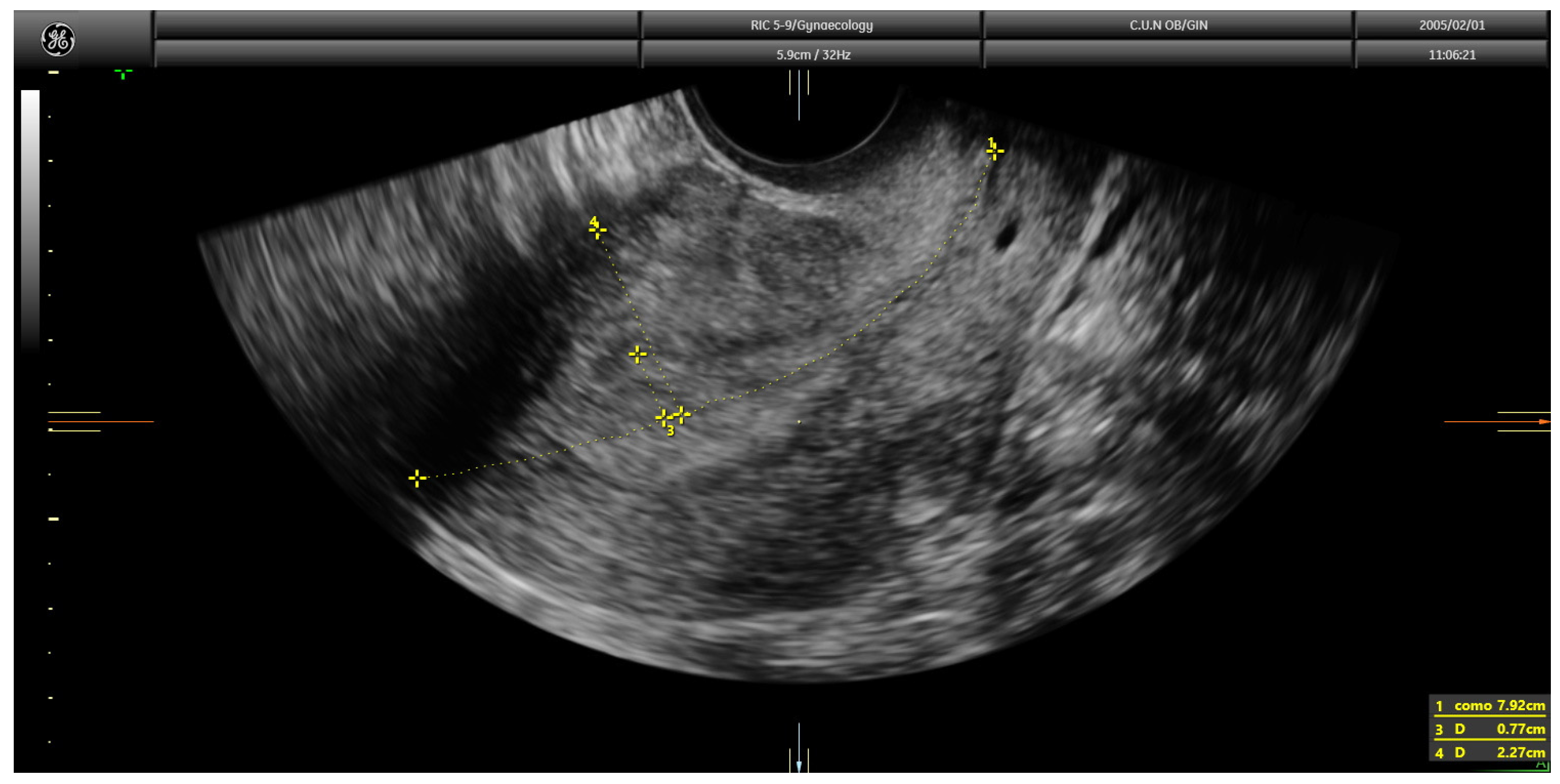
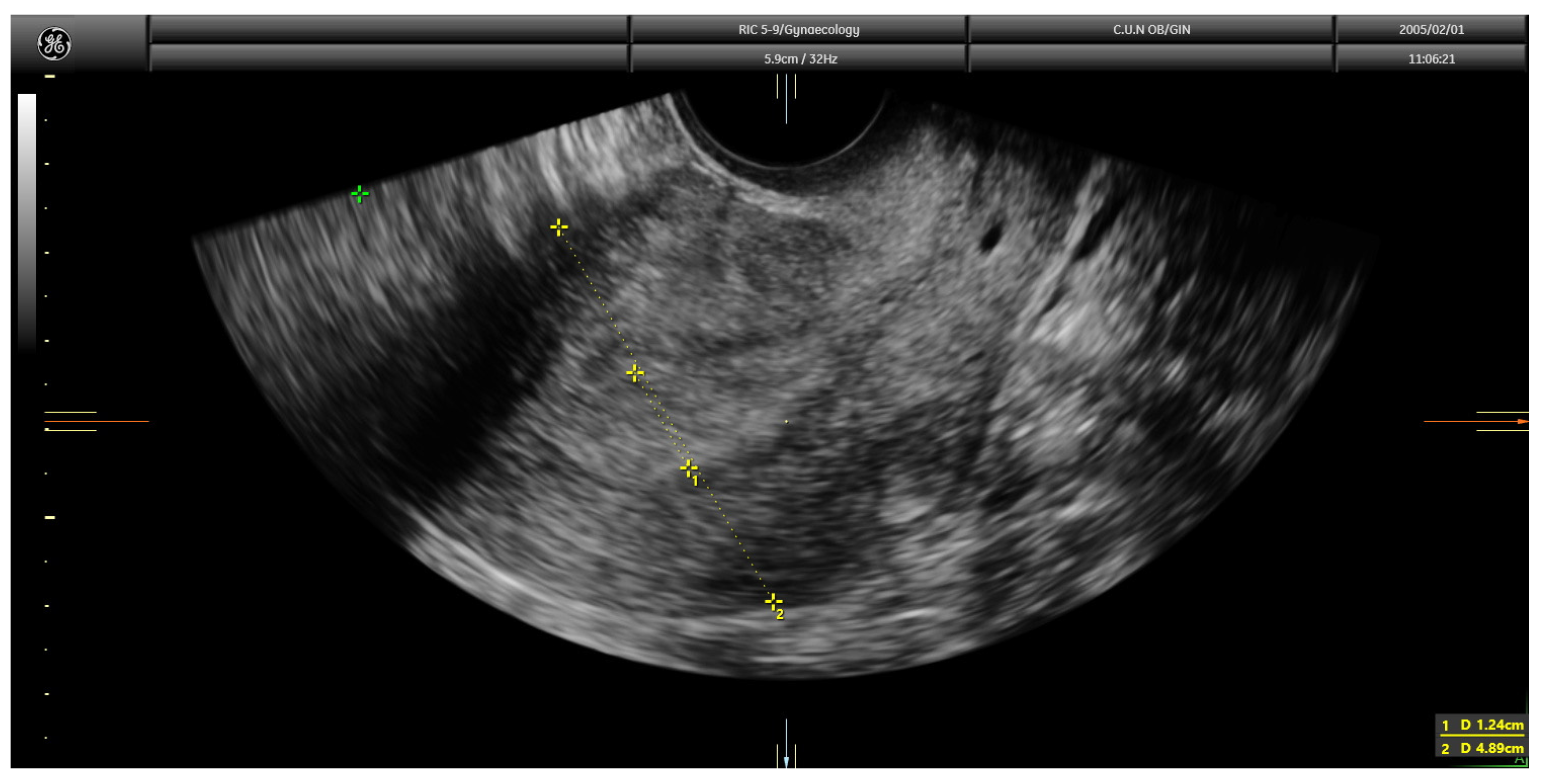
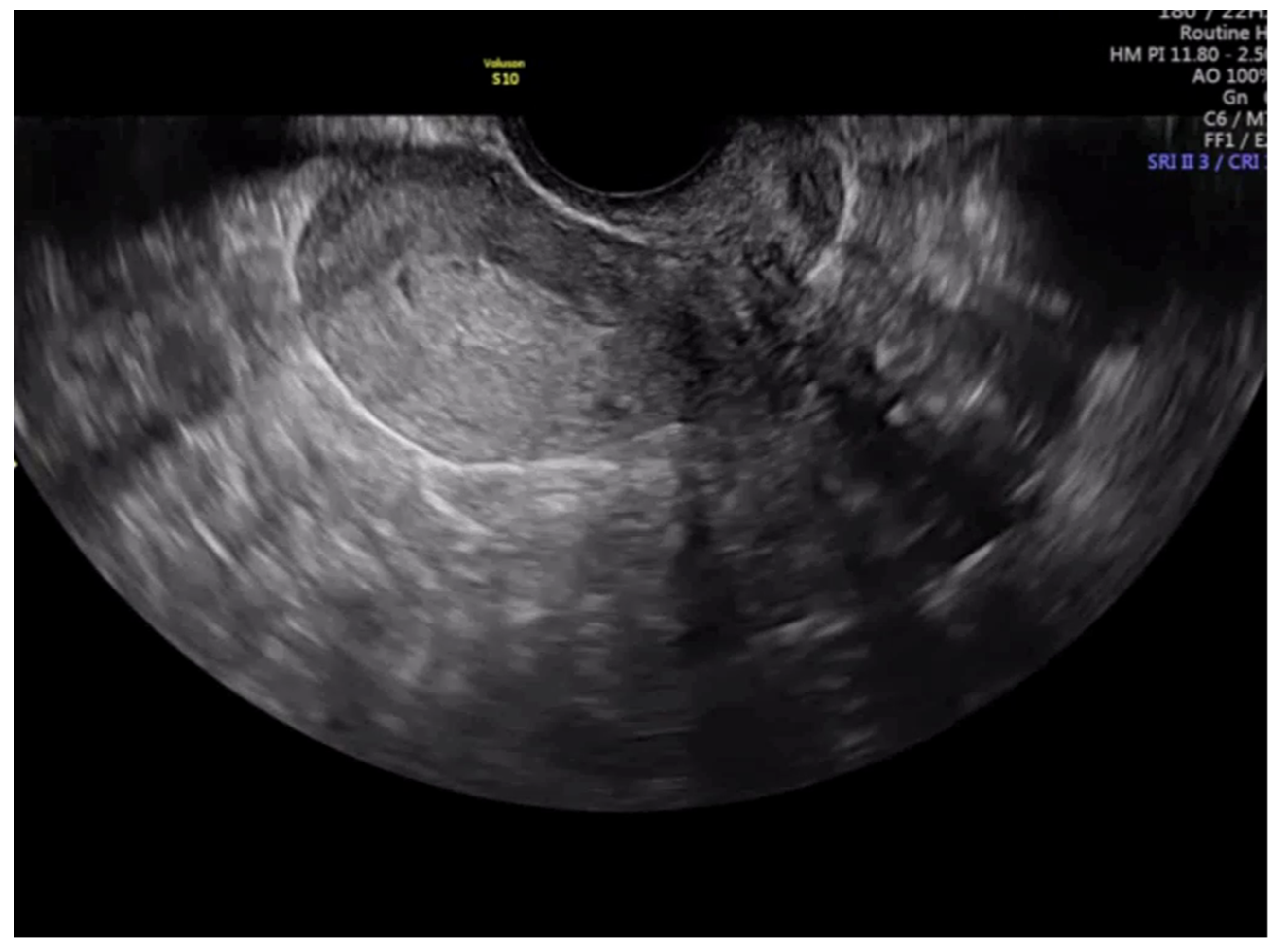


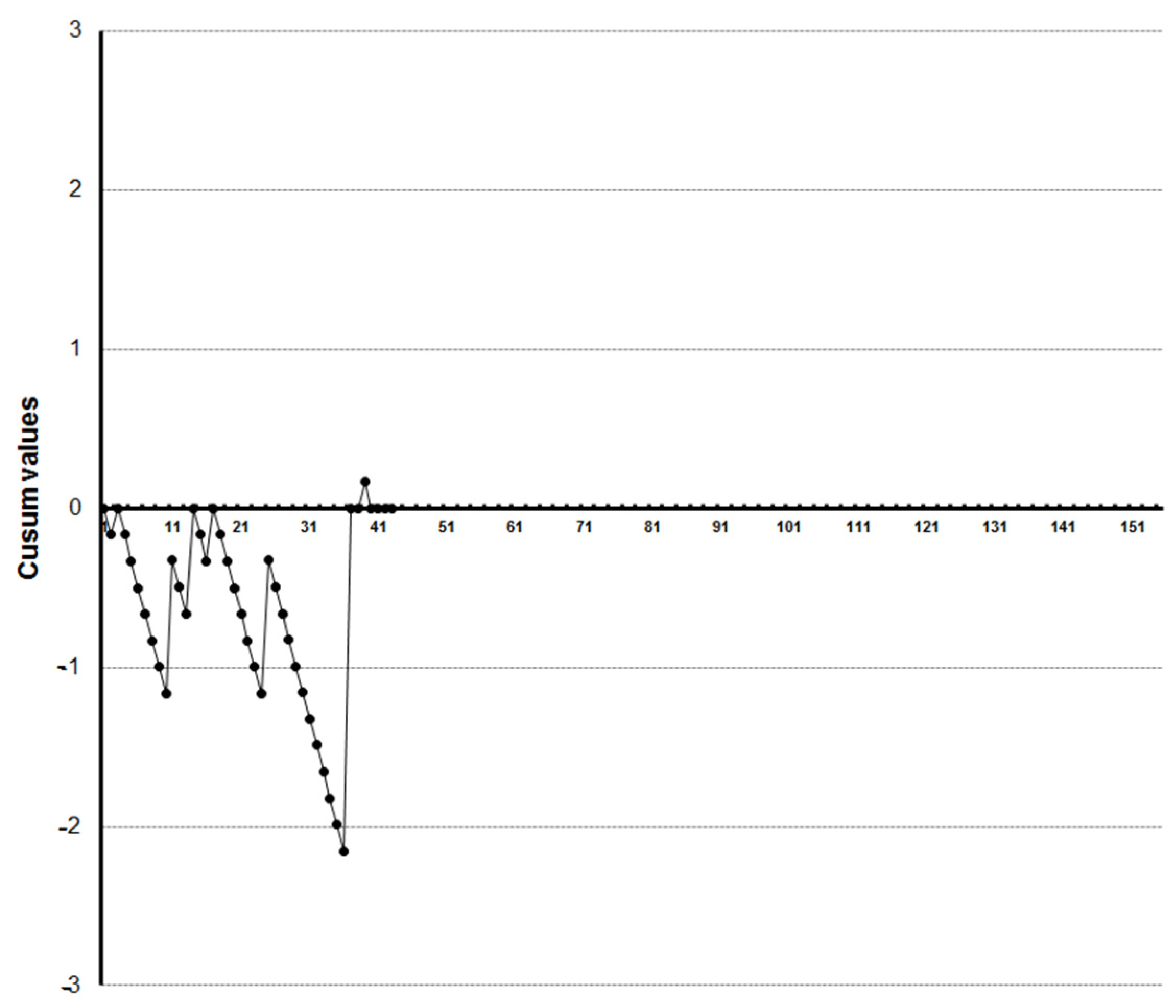

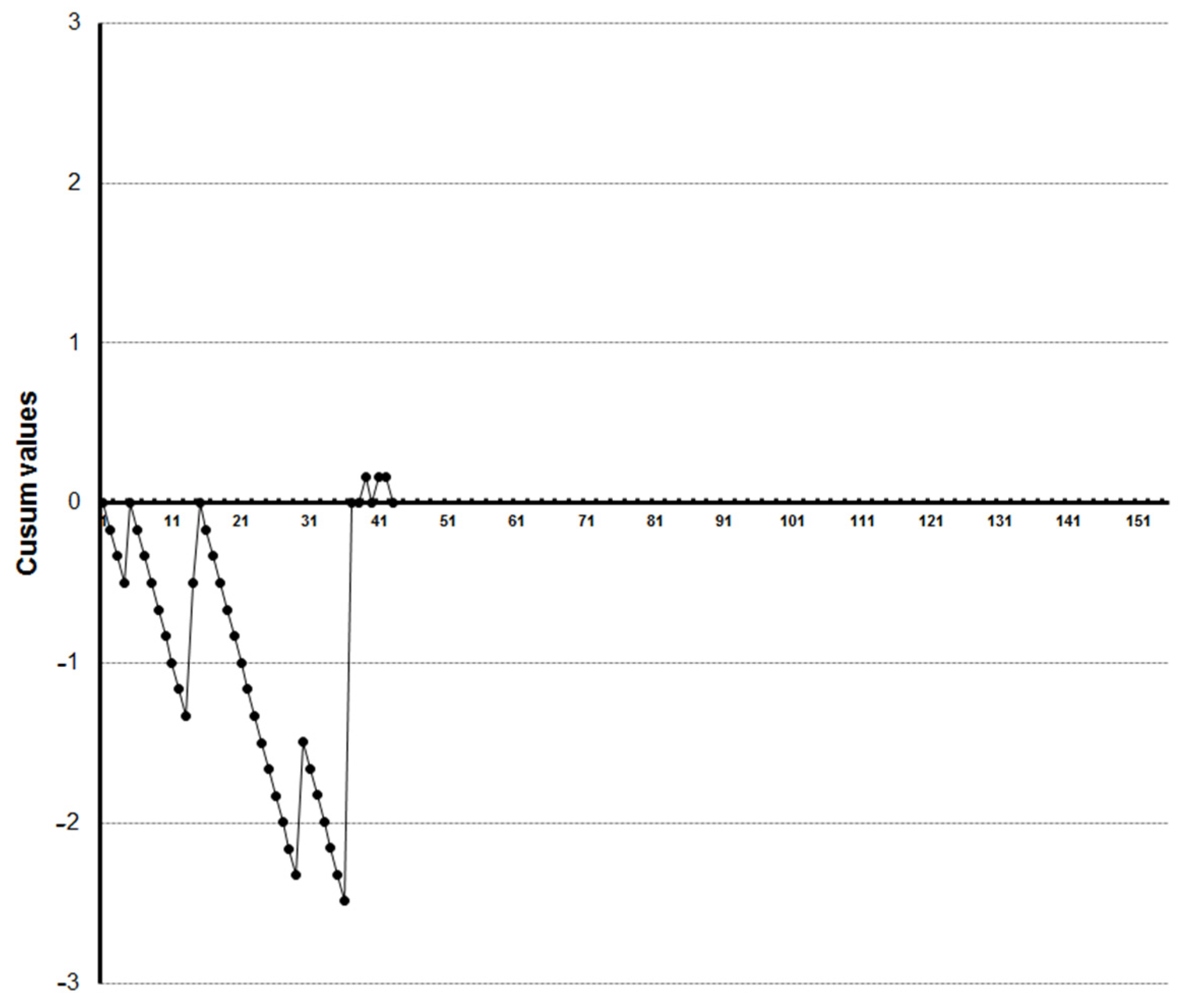

Disclaimer/Publisher’s Note: The statements, opinions and data contained in all publications are solely those of the individual author(s) and contributor(s) and not of MDPI and/or the editor(s). MDPI and/or the editor(s) disclaim responsibility for any injury to people or property resulting from any ideas, methods, instructions or products referred to in the content. |
© 2023 by the authors. Licensee MDPI, Basel, Switzerland. This article is an open access article distributed under the terms and conditions of the Creative Commons Attribution (CC BY) license (https://creativecommons.org/licenses/by/4.0/).
Share and Cite
Chacón, E.; Marucco, J.; Martinez, I.; Monroy, A.; Laza, M.V.; Tomaizeh, A.; Pascual, M.Á.; Guerriero, S.; Alcázar, J.L. Learning Curve for Ultrasound Assessment of Myometrial Infiltration in Endometrial Cancer Visualizing Videoclips: Potential Implications for Training. Diagnostics 2023, 13, 425. https://doi.org/10.3390/diagnostics13030425
Chacón E, Marucco J, Martinez I, Monroy A, Laza MV, Tomaizeh A, Pascual MÁ, Guerriero S, Alcázar JL. Learning Curve for Ultrasound Assessment of Myometrial Infiltration in Endometrial Cancer Visualizing Videoclips: Potential Implications for Training. Diagnostics. 2023; 13(3):425. https://doi.org/10.3390/diagnostics13030425
Chicago/Turabian StyleChacón, Enrique, Julia Marucco, Irene Martinez, Alba Monroy, Maria Victoria Laza, Aida Tomaizeh, Maria Ángela Pascual, Stefano Guerriero, and Juan Luis Alcázar. 2023. "Learning Curve for Ultrasound Assessment of Myometrial Infiltration in Endometrial Cancer Visualizing Videoclips: Potential Implications for Training" Diagnostics 13, no. 3: 425. https://doi.org/10.3390/diagnostics13030425
APA StyleChacón, E., Marucco, J., Martinez, I., Monroy, A., Laza, M. V., Tomaizeh, A., Pascual, M. Á., Guerriero, S., & Alcázar, J. L. (2023). Learning Curve for Ultrasound Assessment of Myometrial Infiltration in Endometrial Cancer Visualizing Videoclips: Potential Implications for Training. Diagnostics, 13(3), 425. https://doi.org/10.3390/diagnostics13030425





